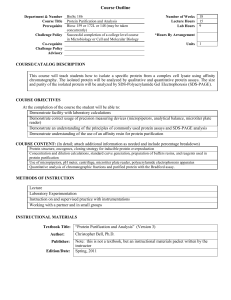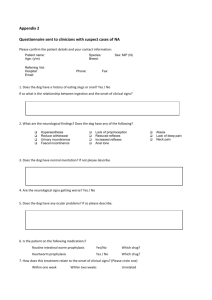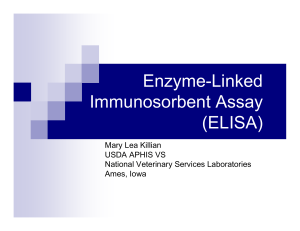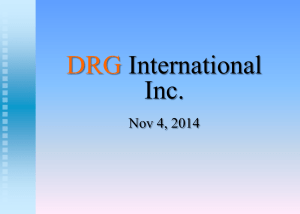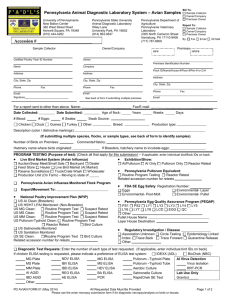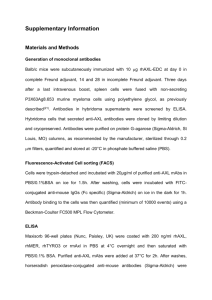BIOSC 184-S14 - Contra Costa College
advertisement
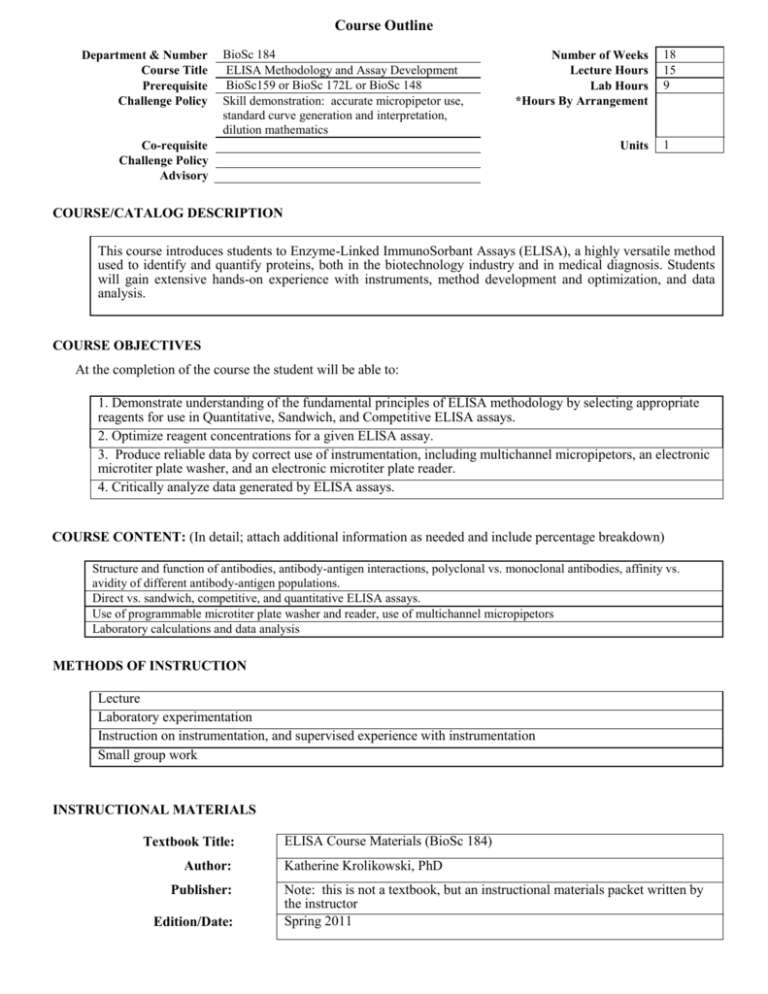
Course Outline Department & Number Course Title Prerequisite Challenge Policy BioSc 184 ELISA Methodology and Assay Development BioSc159 or BioSc 172L or BioSc 148 Skill demonstration: accurate micropipetor use, standard curve generation and interpretation, dilution mathematics Number of Weeks Lecture Hours Lab Hours *Hours By Arrangement Co-requisite Challenge Policy Advisory Units 18 15 9 1 COURSE/CATALOG DESCRIPTION This course introduces students to Enzyme-Linked ImmunoSorbant Assays (ELISA), a highly versatile method used to identify and quantify proteins, both in the biotechnology industry and in medical diagnosis. Students will gain extensive hands-on experience with instruments, method development and optimization, and data analysis. COURSE OBJECTIVES At the completion of the course the student will be able to: 1. Demonstrate understanding of the fundamental principles of ELISA methodology by selecting appropriate reagents for use in Quantitative, Sandwich, and Competitive ELISA assays. 2. Optimize reagent concentrations for a given ELISA assay. 3. Produce reliable data by correct use of instrumentation, including multichannel micropipetors, an electronic microtiter plate washer, and an electronic microtiter plate reader. 4. Critically analyze data generated by ELISA assays. COURSE CONTENT: (In detail; attach additional information as needed and include percentage breakdown) Structure and function of antibodies, antibody-antigen interactions, polyclonal vs. monoclonal antibodies, affinity vs. avidity of different antibody-antigen populations. Direct vs. sandwich, competitive, and quantitative ELISA assays. Use of programmable microtiter plate washer and reader, use of multichannel micropipetors Laboratory calculations and data analysis METHODS OF INSTRUCTION Lecture Laboratory experimentation Instruction on instrumentation, and supervised experience with instrumentation Small group work INSTRUCTIONAL MATERIALS Textbook Title: Author: Publisher: Edition/Date: ELISA Course Materials (BioSc 184) Katherine Krolikowski, PhD Note: this is not a textbook, but an instructional materials packet written by the instructor Spring 2011 COURSE EXPECTATIONS (Use applicable expectations) Outside of Class Weekly Assignments Hours per week Weekly Reading Assignments Weekly Writing Assignments Weekly Math Problems Lab or Software Application Assignments Other Performance Assignments 1 1 STUDENT EVALUATION: (Show percentage breakdown for evaluation instruments) 70 30 % % % % Analyses of data generated by ELISA experiments (lab write ups) Homework and in-class worksheet assignments GRADING POLICY (Choose LG, CR/NC, or SC) X Letter Grade 90% - 100% = A 80% - 89% = B 70% - 79% = C 60% - 69% = D Below 60% = F Pass / No Pass 70% and above = Pass Below 70% = No Pass Prepared by: Katherine Krolikowski, PhD Content Review Date: October, 2013 Revised 04/13 Student Choice 90% - 100% = A 80% - 89% = B 70% - 79% = C 60% - 69% = D Below 60% = F or 70% and above = Pass Below 70% = No Pass
